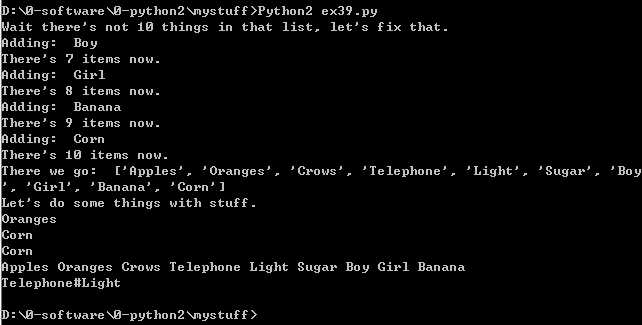标签:es2017 一件事 one ora 工作原理 type obj eth .com
你已经学过了列表。在你学习“while 循环”的时候,你对列表进行过“追加(append)”操作,而且将列表的内容打印了出来。另外你应该还在加分习题里研究过 Python 文档,看了列表支持的其他操作。这已经是一段时间以前了,所以如果你不记得了的话,就回到本书的前面再复习一遍把。
找到了吗?还记得吗?很好。那时候你对一个列表执行了 append 函数。不过,你也许还没有真正明白发生的事情,所以我们再来看看我们可以对列表进行什么样的操作。
当你看到像 mystuff.append(‘hello‘) 这样的代码时,你事实上已经在 Python 内部激发了一个连锁反应。以下是它的工作原理:
大部分时候你不需要知道这些细节,不过如果你看到一个像这样的 Python 错误信息的时候,上面的细节就对你有用了:
1 $ python 2 Python 2.6.5 (r265:79063, Apr 16 2010, 13:57:41) 3 [GCC 4.4.3] on linux2 4 Type "help", "copyright", "credits" or "license" for more information. 5 >>> class Thing(object): 6 ... def test(hi): 7 ... print "hi" 8 ... 9 >>> a = Thing() 10 >>> a.test("hello") 11 Traceback (most recent call last): 12 File "<stdin>", line 1, in <module> 13 TypeError: test() takes exactly 1 argument (2 given) 14 >>>
就是这个吗?嗯,这个是我在 Python 命令行下展示给你的一点魔法。你还没有见过class 不过后面很快就要碰到了。现在你看到 Python 说 test() takes exactly 1 argument (2 given) (test() 只可以接受1个参数,实际上给了两个)。它意味着 python 把 a.test("hello") 改成了 test(a, "hello") ,而有人弄错了,没有为它添加 a 这个参数。
一下子要消化这么多可能有点难度,不过我们将做几个练习,让你头脑中有一个深刻的印象。下面的练习将字符串和列表混在一起,看看你能不能在里边找出点乐子来:

1 ten_things = "Apples Oranges Crows Telephone Light Sugar" 2 3 print "Wait there‘s not 10 things in that list, let‘s fix that." 4 5 stuff = ten_things.split(‘ ‘) 6 more_stuff = ["Day", "Night", "Song", "Frisbee", "Corn", "Banana", "Girl", "Boy"] 7 8 while len(stuff) != 10: 9 next_one = more_stuff.pop() 10 print "Adding: ", next_one 11 stuff.append(next_one) 12 print "There‘s %d items now." % len(stuff) 13 14 print "There we go: ", stuff 15 16 print "Let‘s do some things with stuff." 17 18 print stuff[1] 19 print stuff[-1] # whoa! fancy 20 print stuff.pop() 21 print ‘ ‘.join(stuff) # what? cool! 22 print ‘#‘.join(stuff[3:5]) # super stellar!

1.
标签:es2017 一件事 one ora 工作原理 type obj eth .com
原文地址:http://www.cnblogs.com/yllinux/p/7616333.html